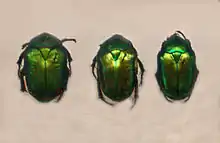| Protaetia speciosa | |
|---|---|
 | |
%252C_Entomica.jpg.webp) | |
| P.s. jousselini at Prague's National Museum (top), P.s. cyanochlora at Entomica Insectarium (bottom) | |
| Scientific classification | |
| Domain: | Eukaryota |
| Kingdom: | Animalia |
| Phylum: | Arthropoda |
| Class: | Insecta |
| Order: | Coleoptera |
| Family: | Scarabaeidae |
| Genus: | Protaetia |
| Species: | P. speciosa |
| Binomial name | |
| Protaetia speciosa (Adams, 1817) | |
| Synonyms | |
| |
Protaetia speciosa is a beetle of the family Scarabaeidae and subfamily Cetoniinae.
Description
Protaetia speciosa can reach a body length of about 23–30 mm (0.9–1.2 in). The basic colour of the body typically is metallic golden-green, but depending on subspecies sometimes red or blue. Adults can be found from May to October, with a peak in June–August. These beetles feed primarily on tree sap and fruits. The larvae develop in rotten wood of deciduous trees, mainly oak and willow.
Distribution
This flower beetle is present in the Near East and far southeastern Europe, in northern Iraq, Syria, northern Iran, Georgia, Armenia, Azerbaijan, Turkmenistan, Ukraine, southernmost Russia and Romania.
Habitat
This beetle lives in deciduous forests, in plains and mountains.
Subspecies
- Protaetia speciosa cyanochlora Schauer, 1941
- Protaetia speciosa jousselini (Gory & Percheron, 1833)
- Protaetia speciosa speciosa (Adams, 1817)
- Protaetia speciosa venusta (Ménétriès, 1836)
References
External links
This article is issued from Wikipedia. The text is licensed under Creative Commons - Attribution - Sharealike. Additional terms may apply for the media files.